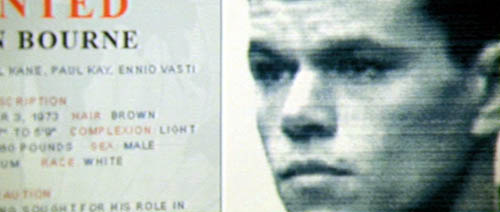 I love how author David Bordwell launches into a topic and digs deep. One of his terrific articles is "Unsteadicam Chronicles," from his website. I don't necessarily agree with his viewpoints, but I adore how deeply involved he gets with his material.
I love how author David Bordwell launches into a topic and digs deep. One of his terrific articles is "Unsteadicam Chronicles," from his website. I don't necessarily agree with his viewpoints, but I adore how deeply involved he gets with his material.Personally, I thought the camerawork and cinematography of "The Bourne Supremacy" was brilliant. (Unfortunately, I haven't seen "Ultimatum" yet.) Like J.J. Abrams' "Mission: Impossible III," the Paul Greengrass' Bourne films, as well as Doug Liman's original Bourne film, are point-of-view superspy films, and the camerawork reflects this. In these cases, I believe that the handheld work does not camouflage or hide shoddy staging, set design, or acting (as his article suggests). The camera is moving as fast as our hero spy, and sometimes the speed is so intense that makes a scene abstract. I'm thinking primarily of "Supremacy's" car chase, with frequent cutting to blurry, intense Bourne-point-of-view shots.
However, as a general rule, I think is it paramount for a filmmaker to set up the geography of an action scene so that the audience can follow along with the choreography.
James Cameron is the undisputed master of orchestrating complex action sequences that take place over large expanses of space, and yet the geography is expertly laid out for the audience, allowing the audience to fully enjoy the sequence (see "Terminator 2," "True Lies," "Titanic," and "Aliens"). The opposite is true of Michael Bay, whose style suggests that every single shot is a hero shot, and its context is irrelevant ("Transformers," "Bad Boys II," "Armageddon").
As you may have guessed, I have a few articles in the pipeline concerning this subject. We'll be examining the construction of an action sequence from Cameron's "True Lies," as well as a scene from Bay's "Transformers," to illustrate how to create (and destroy) an audiences' sense of geography for an action sequence.
- David Bordwell, Part I: "Unsteady Chronicles"
- David Bordwell, Part II: "Insert Your Favorite Bourne Pun Here"
- David Bordwell, Part III: "I Broke Everything New Again"

4 comments:
"James Cameron is the undisputed master of orchestrating complex action sequences that take place over large expanses of space, and yet the geography is expertly laid out for the audience, allowing the audience to fully enjoy the sequence..."
Cameron is good (if somewhat hamhandedly obvious at times) but for sheer graceful audacity in orchestrating action setpieces (albeit in less, um, titanic spaces), I'll say Brian dePalma is the master. (Cf. The Untouchables, Blowout, Femme Fatale, Carlito's Way, Casualties of War, et al.).
I just saw Bourne Supremacy last night. While I think they did a phenomenal job in the editing room in keeping the scene somewhat coherent, I found the camera work a little tiring after a while. I think that allowing the audience to slow down and breathe just a bit more where appropriate (did we really need a shaky cam Google internet searching montage?) might have resulted in a better flow. I found myself drifting in and out of the action just because my eyes needed a break after a while.
As far as general shaky cam technique, it was well done- and what a great movie overall! Excellent acting with a tight and economical script.
P
I have to say that in my 30 years of watching movies, the Bourne Supremacy takes the cake in my book of the WORST camera work ever for a wide-release film. In fact, the entire Bourne franchise would have been much more enjoyable to watch if it wasn't for the poor shakycam (with "Supremacy" being the worst of the three). The car chase you mention is the prime example of what not to do during a car chase...I mean really....there were shots that looked like mistakes where the camera was just looking at nothing. Thankfully, "Ultimatum" had better camera work overall but could have used some restraint during the fight scenes which were very well choreographed.
I still maintain that the camera work in SUPREMACY was character-based. There are only a few other movies whose camera movement could be considered 'shakey' that I actually enjoy. But, for the most part, I think audiences crave intense action sequences with clearly composed shots, with an understanding of the basic geography of the scene. Just as an example: John Frankenheimer's "Ronin" (1998) has some extraordinary car chases and gunfight sequences, all of which were classically shot with clear lines of direction, understandable spaces, and brilliant editing that constantly helps the audience understand what is going on.
Post a Comment